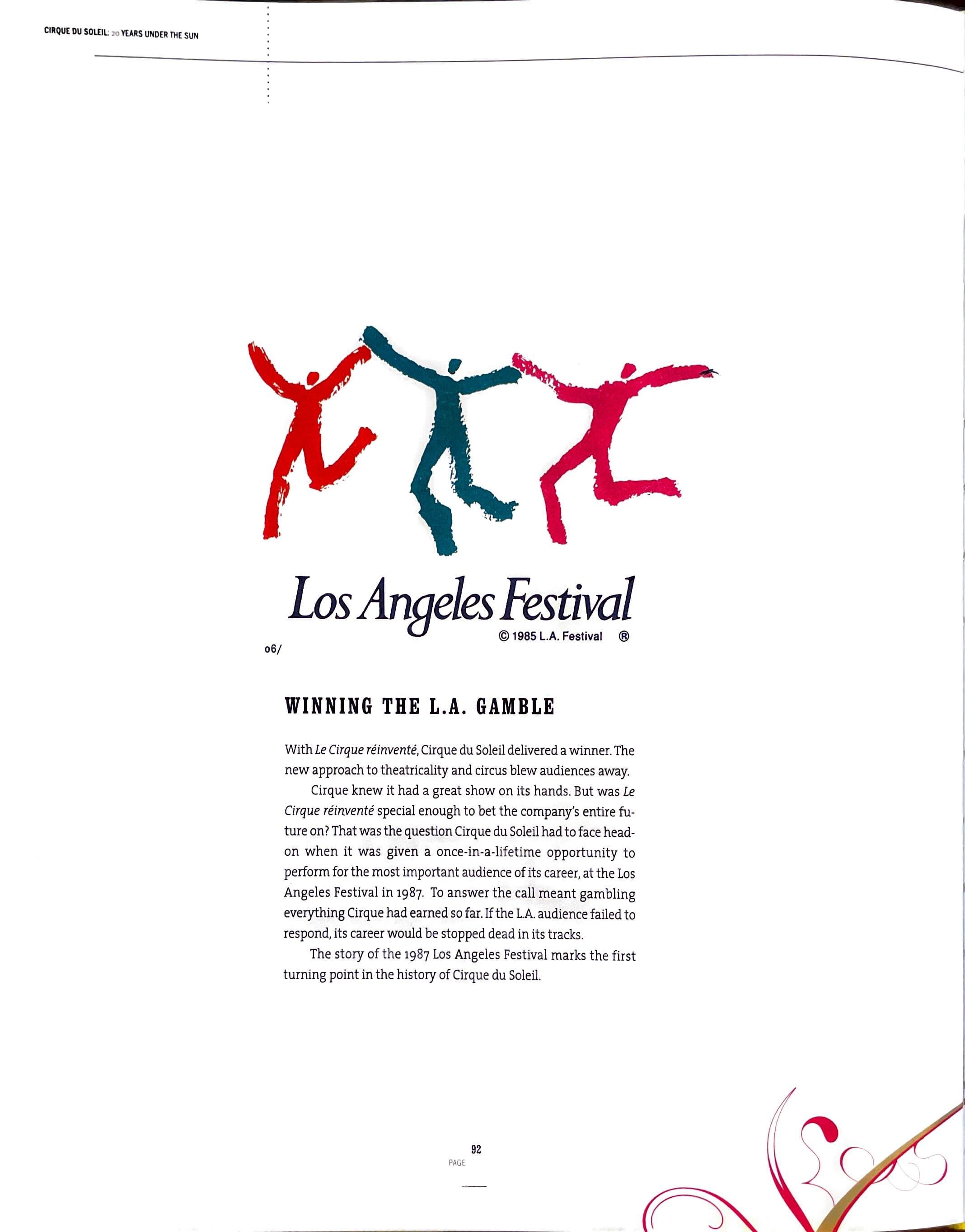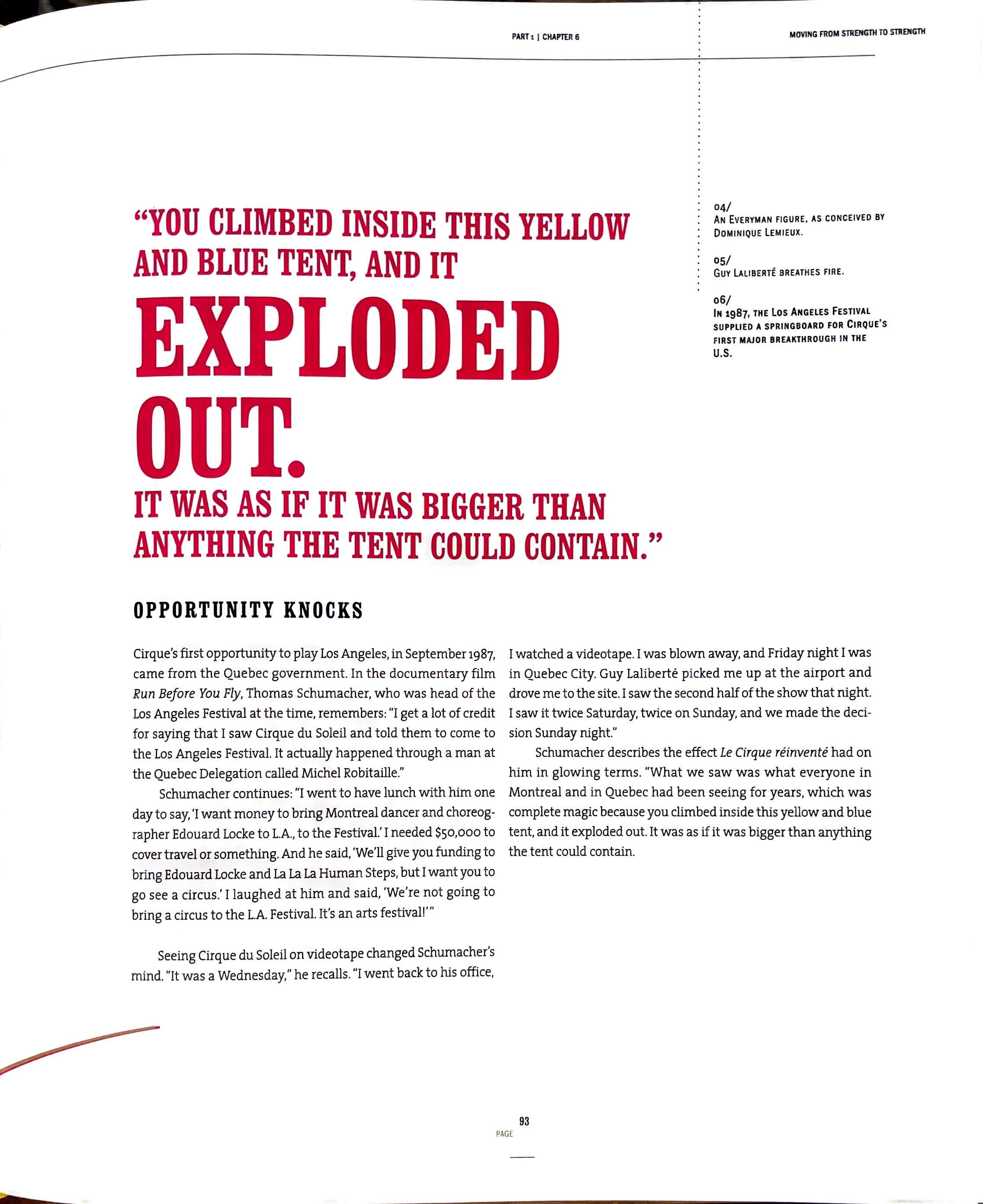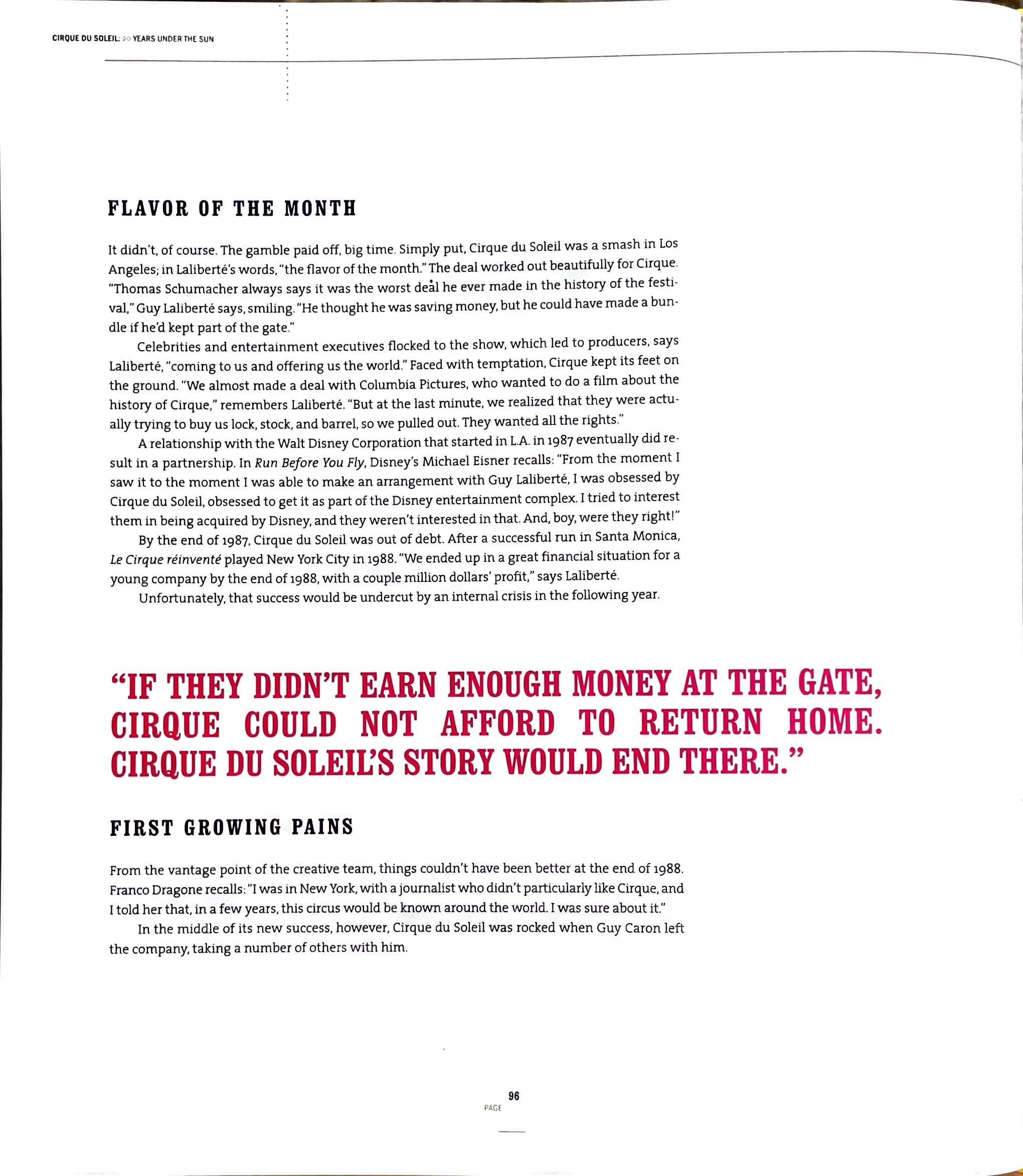06/
WINNING THE L.A. GAMBLE
With Le Cirque reinvente, Cirque du Soleil delivered a winner. The new approach to theatricality and circus blew audiences away. Cirque knew it had a great show on its hands. But was Le Cirque reinvente special enough to bet the company's entire future on? That was the question Cirque du Soleil had to face headon when it was given a once-in -a-lifetime opportun ity to perform for the most important audience of its career, at the Los Angeles Festival in 1987 To answer the call meant gambling everything Cirque had earned so far. If the L.A. audience failed to respond, its career would be st opped dead in its tracks.
The story of the 1987 Los Angeles Fest ival marks th e first turning point in the history of Cirque du Soleil.

"YOU CLIMBED INSIDE THIS YELLOW AND BLUE TENT, AND IT

IT WAS AS IF IT WAS BIGGER THAN ANYTHING THE TENT COULD CONTAIN."
OPPORTUNITY KNOCKS
Cirque's first opportunity to play Los Angeles, in September 1987, I watched a videotape. I was blown away, and Friday night I was came from the Quebec government. In the documentary film in Quebec City. Guy Laliberte picked me up at the airport and Run Before You Fly, Thomas Schumacher, who was head of the drove me to the site. I saw the second half of the show that night. Los Angeles Festival at the time, remembers : "I get a lot of credit I saw it twice Saturday, twice on Sunday, and we made the decifor saying that I saw Cirque du Soleil and told them to come to sion Sunday night." the Lo s Angeles Fest ival. It actually happened through a man at Schumacher describes the effect Le Cirque reinvente had on the Quebec Delegation called Michel Robitaille." him in glowing terms "What we saw was what everyone in Schumacher continues : "I went to have lunch with him one Montreal and in Quebec had been seeing for years, which was day to say, 'I want money to bring Montreal dancer and choreog- complete magic because you climbed inside this yellow and blue rapher Edouard Locke to L.A., to the Festival.' I needed $ 50,000 to t e nt, and it exploded out. It was as if it was bigger than anything cover travel or something And he said, 'We'll give you funding to the tent could contain bring Edouard Locke and La La La Human Steps , but I want you to go see a circus.' I laughed at him and said, 'We're not going to bring a circus to the L.A. Festival. It's an arts festival!"
Seeing Cirque du Soleil on videotape changed Schumacher's mind. "It was a Wednesday, " h e re calls "I went back to his office,
LET'S MAKE A DEAL
Though Schumacher wanted Cirque du Sole1 l for his festival, he couldn't afford to pay them. "A lot of people don't realize that, when we brought Cirque to America, by the time we booked it. it would have been way too expensive to spend the festival's money to brmg them ," he says
Despite this, Laliberte says the opportunity was too good to pass up "I thought, Tm not gomg to wait twenty years to see if we can make a living off what we do. The opportumty is here. let's make a deal. I told Thomas Schumacher, 'Give us the opening slot, promotio n, and one hundred percent of the gate.'·
"TO LIVE OR DIE IN L. A."
Laliberte habitually refers to the Los Angeles Festival gambit as Cirque's "to live or die in L.A." moment. The simple truth is, at that particular moment in Cirque du Soleil's history, it could only afford a one-way trip to Los Angeles. Transportmg the cast, c rew, and equipment across the continent from Montreal to Los Angeles stretched Cirque's finances to the very limit. If they didn ' t earn enough money at the gate, Cirque could not affo rd to return home. Cirque du Sole1l's story would end there.

FLAVOR OF THE MONTH
It didn't, of course The gamble paid off, big time . Simply put, Cirque du Soleil was a smash in Los Angeles; in Laliberte 's words, "the flavor of the month ." The deal worked out beautifully for Cirque "Thomas Schumacher always says it was the worst deal he ever made in the history of the festi · val, " Guy Laliberte says, smiling. "He thought he was saving money, but he could have made a bu ndle if he'd kept part of the gate "
Celebrities and entertainment executives flocked to the show, which led to producers , says Laliberte , "coming to us and offering us the world." Faced with temptation, Cirque kept its feet on the ground. "We almost made a deal wit h Columbia Pictures, who wanted to do a film about the history of Cirque, " remembers Laliberte. "But at the last minute, we realized that they were actual ly trying to buy us lock , stock, and barrel, so we pulled out. They wanted alJ the rights ."
A re lationship with the Walt Disney Corporation that started in L.A in 1987 eventually did result in a partnership. In Run Before You Fly, Disney's Michael Eisner recalls : "From the moment I saw it to the moment I was able to make an arrangement with Guy Laliberte, I was obsessed by Cirq ue du Soleil, obsessed to get it as part of the Disney entertainment complex I tried to interest them in being acquired by Disney, and they weren't interested in that. And, boy, were they right !"
By the end of 1987, Cirque du Soleil was out of debt. After a success ful run in Santa Monica , Le Cirque reinvente played New York City in 1988. "We ended up in a great financial situation for a young compa n y by the end of 1988, with a couple million dollars' profit," says Laliberte
Unfortu n ately, that success would be undercut by an internal crisis in the following year
"IF THEY DIDN'T EARN ENOUGH MONEY AT THE CIRQUE COULD NOT AFFORD TO RETURN CIRQUE DU SOLEIL'S STORY WOULD END THERE."
FIRST GROWING PAINS

From the vantage point of the creative team, things couldn't have been better at the end of 1988 Franco Dragone recalls : "I
